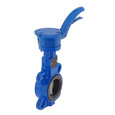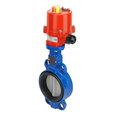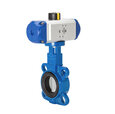What is a Butterfly Valve?
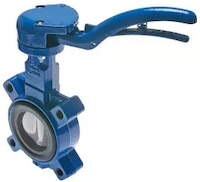
Figure 1: Butterfly valve
Butterfly valves are quarter-turn valves that are popular for on-off or modulating services. They are lightweight, have a small installation footprint, lower cost, quick operation, and are available with large orifice sizes. The “butterfly" is a disk connected to a rod. When the valve opens, the disk rotates to allow fluid to pass through. It closes when the rod rotates the disc by a quarter turn to a position perpendicular to the flow direction. In this article you will learn how a butterfly valve works, what are the different types of butterfly valves, what actuation options are available for these valves, and more.
Table of contents
- Principle of operation
- Types of butterfly valves
- Actuation method
- Butterfly valve wiring
- Applications
- Ball valve vs butterfly valve
- FAQs
View our online selection of butterfly valves!
Principle of operation
Butterfly valves have a relatively simple construction. Figure 2 shows the main components of a butterfly valve, which are the body, seal, disc, and stem. The disc (Figure 2 labeled E) of a butterfly valve aligns with the center of the connected piping and the stem (Figure 2 labeled B) connects to an actuator or handle on the outside of the valve. In the closed position, the disc is perpendicular to the flow, as shown in Figure 2, and seals against the valve seat (Figure 2 labeled D). An o-ring (Figure 2 labeled C) in the stem packing seals against leakage along the stem. When the actuator or handle rotates the butterfly valve stem 90°, the disc also rotates 90° to become parallel to the flow. Partial rotation allows for the flow to be throttled or proportional.
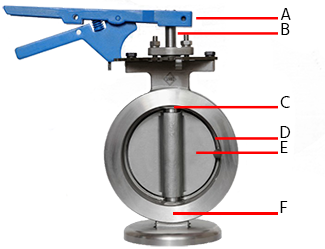
Figure 2: Parts of a butterfly valve: disk (A), stem (B), handle (C), seal (D), o-ring (E), valve body (F)
Butterfly valves used for modulating services can have a linear or an equal percentage characteristic.
- Linear: When the disc opens X%, the flow rate is at X% of the maximum flow rate. For example, if the disc is opened 1/3 of a turn (30 degrees), the flow rate will be 33.3% of maximum.
- Equal: There is a logarithmic relationship between disc travel and flow rate. For example, if the disc rotates 10 degrees and the flow rate increases from 100 to 170 m3/h, which is a 70% increase, then the next 10 degree rotation will cause the flow rate to increase from 170 to 289 m3/h, which is also a 70% increase. For advanced butterfly valves, this relationship is possible from 20 to 90 degrees (fully open).
The symbol for a butterfly valve is shown below:
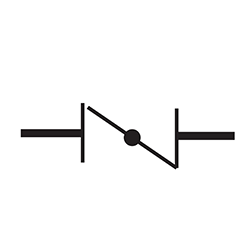
Figure 3: Butterfly valve symbol
Types of butterfly valves
Butterfly valves come in different designs, each serving specific applications and pressure ranges. Butterfly valves can be categorized based on their disc closure design, connection design, and actuation method.
Disc closure design
Butterfly valves can be concentric or eccentric depending on the location of the stem in relation to the disc’s centerline and the surface angle of the valve seat.
Concentric
The most basic design of a butterfly valve is a centric or concentric butterfly valve. The stem passes through the disc’s centerline, and the seat is the inside diameter periphery of the valve body (Figure 4 on the left). This zero-offset valve design is known as resilient-seated because efficient sealing relies on the flexibility of the rubber seat. When closing, the disc first comes into contact with the seat at around 85° during a 90° rotation. Concentric butterfly valves are suitable for low-pressure ranges.
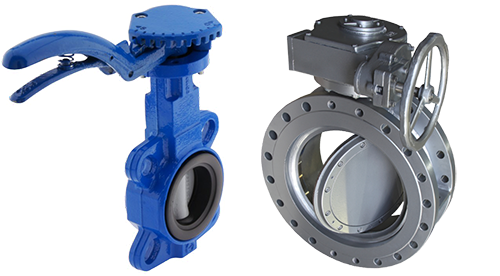
Figure 4: A zero-offset butterfly valve with a lever handle (left) and an eccentric butterfly valve with a hand wheel (right).
Eccentric
An eccentric butterfly valve’s stem does not pass through the centerline of the disc but instead behind it (opposite of flow direction), as seen in Figure 4 (right). A single offset butterfly valve’s stem is directly behind the disc’s centerline. This design reduces how much the disc contacts with the seal before the valve fully closes. Less contact improves the service life of the valve.
In a double offset or doubly eccentric butterfly valve, the stem is behind the disc’s centerline with an additional offset to one side (Figure 5). The stem’s double eccentricity design reduces disc and seat contact to the last 1-3° of disc closure.
A triple offset butterfly valve (TOV or TOBV) is suitable for critical applications and has a similar design to a double offset butterfly valve. The third offset is the disc-seat contact axis. The seat surface has a conical shape which, coupled with the same shape at the ridge of the disc, results in minimal contact before full closure of the valve. A triple offset butterfly valve is more efficient and experiences less wear. Triple offset valves are often made of metal seats for a bubble-tight shut-off. The metal seats make butterfly valves suitable for higher temperature ranges.
High-performance butterfly valves use the pressure in the pipeline to increase the seal between the seat and the disc edge. These butterfly valves have higher pressure ratings and are prone to less wear.
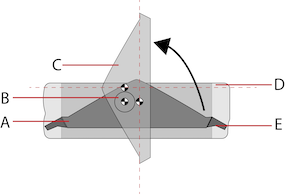
Figure 5: Top view schematic of an eccentric butterfly valve: seat (A, E), stem (B), disc in open position (C), and body (D)
Connection design
Butterfly valves can connect to a piping system in different ways. The most common connections are wafer type, lug type, and flange.
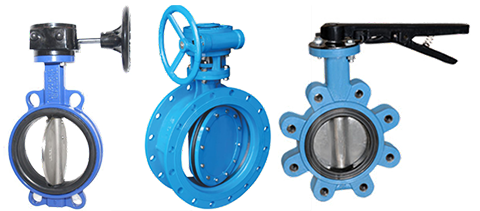
Figure 6: Butterfly valve connection types: Wafer type butterfly valve (left), Flanged butterfly valve (middle), and lug-style butterfly valve (right).
Wafer-style
The most cost-effective version, a wafer-style butterfly valve sandwiches between two pipe flanges. Long bolts that cross the entire valve body connect the pipe flanges. This connection type is suitable for sealing against bi-directional differential pressures and preventing backflow in systems designed for universal flow. Some versions of this valve have flange holes outside the valve body (Figure 6 labeled A). Gaskets, o-rings, and flat valve faces on both sides of the valve combine together to accomplish efficient sealing.
Lug-style
The lug-style butterfly valve has threaded inserts (lugs) outside the valve body (Figure 6 labeled C). Two sets of bolts, without nuts, connect pipe flanges to each side of the bolt inserts. This design enables the disconnection of one side without affecting the other’s function for dead-end service. Lug-style butterfly valves used in dead-end service generally have a lower pressure rating. And unlike wafer butterfly valves, lug-style valves carry the weight of the piping through the valve body.
Actuation method
Butterfly valves can be operated manually by handles and gears or automatically by electric, pneumatic, or hydraulic actuators. These devices allow precise disc rotation to positions ranging from fully open to fully closed. A brief description of the different types of actuation methods is below.
Manual butterfly valve
Manually actuated butterfly valves are inexpensive and easy to operate. The two common methods are:
- Hand lever: A hand lever is common for small butterfly valves. The handle enables the valve to be locked into an open, partially open, or closed position. An example can be seen in Figure 4 (left). Extended spindle butterfly valves have long stems allowing remote operation of the valve when it is underground or within a pit.
- Gear: These are designed for slightly larger butterfly valves and utilize a gearbox to increase torque at the expense of decreased speed of opening/closing. Gear-operated valves are also self-locking (cannot be back-driven) and can be equipped with position indicators. An example can be seen in Figure 4 (right).
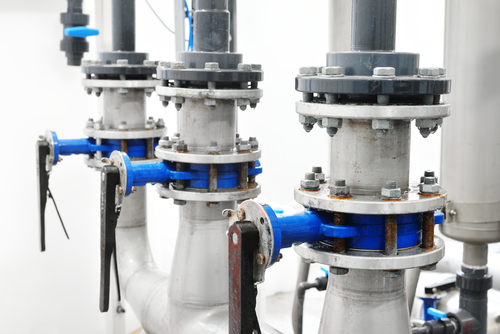
Figure 7: Manual butterfly valves
Actuated butterfly valve
Power-operated actuators are a reliable method of controlling butterfly valves from a remote location. Butterfly valve actuators also make rapid operation of larger valves possible. These actuators can be designed to fail-open (stay open in case of actuator failure), fail-close (remain closed in case of actuator failure), and often come with a manual actuation method in case of failure, as seen in Figure 8. The three types of automatic actuators are listed below:
- Electric (motorized) butterfly valve: Uses an electric motor to turn the butterfly valve stem. Learn more about electric actuators.
- Pneumatic butterfly valve: Requires compressed air to move a piston or diaphragm to open/close the valve, as seen in Figure 8. Learn more about pneumatic actuators.
- Hydraulic butterfly valve: Requires hydraulic pressure to move a piston or diaphragm to open/close the valve.
ISO standards for actuated butterfly valves
- ISO 5211: ISO 5211 is an international standard that specifies requirements for the attachment of part-turn actuators (with or without gearboxes) to industrial valves. ISO 5211 specifies the flange dimensions and driving component dimensions of part-turn actuators necessary to attach them to the driven components, along with the reference values for torques for interfaces and couplings. For more information about ISO 5211, please read our ISO 5211 article.
- ISO 5752: ISO 5752 standard for butterfly valves specifies the basic series of face-to-face and center-to-face dimensions for two-way metal butterfly valves.
- ISO 10631: ISO 10631 specifies the general requirements for design, materials (e.g. steel, cast iron, ductile iron, copper alloy), pressure/temperature ratings, and testing for butterfly valves having metallic bodies for use in flanged or butt-welding piping systems.
- ISO 16136: ISO 16136 specifies the requirements for the design, functional characteristics, and manufacture of butterfly valves made of thermoplastic materials intended for isolating and control service, their connection to the pipe system, the body materials, and their pressure/temperature rating between − 40 °C and + 120 °C, for a lifetime of 25 years, and also specifies their tests.
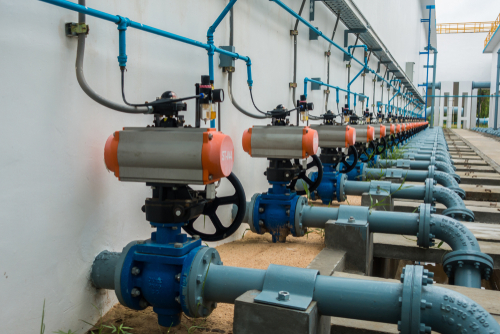
Figure 8: Pneumatic butterfly valves with a handwheel
Butterfly valve wiring
A butterfly valve actuated electrically has two wiring possibilities:
- 2-point control actuators: The three wires in 2-point control actuators are for +, -, and a control wire. The control wire has to be powered to open the valve and unpowered to close the valve or vice versa. This function is especially helpful if the valve is located remotely. The valve remains in the latest position if no power is supplied to the entire unit.
- 3-point control actuators: The four wires in 3-point control actuators are for +, -, and two control wires. The two control signals can close or open the valve depending on which one is powered. 3-point control allows for intermediate stops (partially open). Both of the control wires should not be actuated at the same time, or else the actuator may get damaged.
Applications
Butterfly valves are used in diverse industries and applications such as pharmaceutical, chemical and oil, food, water supply, wastewater treatment, fire protection, gas supply, fuel handling, and sanitary fittings. Butterfly valves for water are used as control valves in pipelines to shut off water flow. These valves are available in huge sizes and are suitable for handling slurries and liquids with relatively large amounts of solids at low pressures. Stainless steel butterfly valves are used in corrosive and marine environmental applications as the material is highly durable and resistant to corrosion.
Ball valve vs butterfly valve
Typically, a butterfly valve with similar characteristics to a ball valve is cheaper, easier to install, and has a smaller installation footprint. However, due to the disc in butterfly valves, they cannot be pigged for cleaning purposes. Ball valves are advantageous for high-pressure, small diameter applications as they are better suited for higher pressure differences and cause minimal pressure drop over the valve. Butterfly valves have a relatively simple design with fewer moving parts and fewer pockets/traps for media. Therefore they are easier to repair and cheaper to maintain. For small pipe diameters a ball valve is typically better suited to the torque and cost. The torque and cost advantages of butterfly valves appear around DN 50 and upwards. Read our article on ball valves vs butterfly valves for a detailed comparison between both valve types.
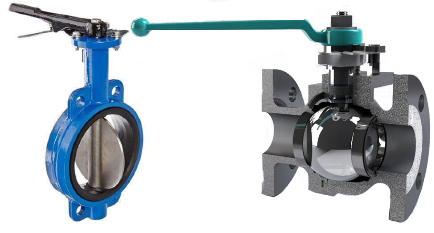
Figure 9: Butterfly valve (left) and ball valve (right)
FAQs
What is a butterfly valve used for?
Butterfly valves are used for on-off or modulated fluid control.
Can you use a butterfly valve for gas?
Yes, butterfly valves can be used for liquids and gasses, but not bulk solids.
What is the advantage of a butterfly valve?
Butterfly valves are lightweight and can be used for both on-off and modulated fluid control.




